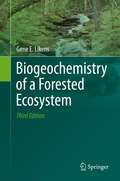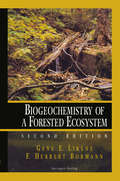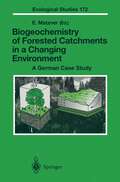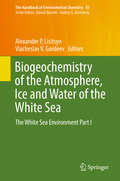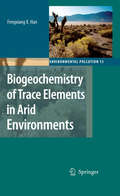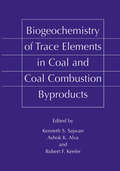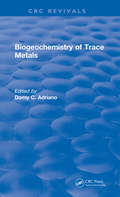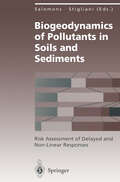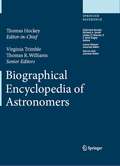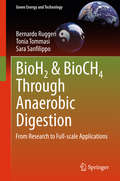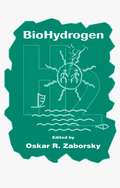- Table View
- List View
Biogeochemistry of a Forested Ecosystem
by Gene E. LikensThe goal of this Third Edition is to update long-term data presented in earlier editions and to generate new syntheses and conclusions about the biogeochemistry of the Hubbard Brook Valley based on these longer-term data. There have been many changes, revelations, and exciting new insights generated from the longer data records. For example, the impact of acid rain peaked during the period of the HBES and is now declining. The longer-term data also posed challenges in that very marked changes in fluxes occurred in some components, such as hydrogen ion and sulfate deposition, calcium and nitrate export in stream water and biomass accumulation, during the almost 50 years of record. Thus, presenting “mean” or “average” conditions for many components for such a long period, when change was so prominent, do not make sense. In some cases, pentads or decades of time are compared to show these changes in a more smoothed and rational way for this long period. In some cases, a single period, often during periods of rapid change, such as acidification, is used to illustrate the main point(s). And, for some elements a unique mass balance approach, allowing the calculation of the Net Ecosystem Flux (NEF), is shown on an annual basis throughout the study.
Biogeochemistry of a Forested Ecosystem
by Gene E. Likens F.Herbert BormannWhen we originally published Biogeochemistry of a Forested Ecosystem in 1977, the Hubbard Brook Ecosystem Study (HBES) had been in existence for 14 years, and we included data through 1974, or a biogeo chemical record of 11 years. Now our continuous, long-term biogeo chemical records cover more than 31 years, and there have been many changes. The most notable change, however, is that three of our coauthors on the original volume are now deceased. They are deeply missed in so many ways. In spite of the longer records, different trends, and new insights, we believe that the basic concepts and approaches we presented in 1977 represent the most valuable contribution of the original edition. They are still valid and useful, particularly for an introductory study of, or course in, biogeochemistry. Our goal in this revision is to preserve these fea tures, correct errors, and revise or eliminate misleading or ambiguous short-term data (11 years!), while maintaining approximately the original length and the modest cost.
Biogeochemistry of Forested Catchments in a Changing Environment: A German Case Study (Ecological Studies #172)
by Egbert MatznerForest ecosystems represent a major type ofland use in Germanyand in Europe. They provide a number of functions, or ecosystem services, beneficial to humans, namely biomass production, regulation of the water- and energy cyde, C and N sequestration, erosion control, recreation, and they act as habitat for numerous species. The stability of forest ecosystems in Europe as influenced by the deposition of air pollutants has been a matter of debate for more than 20 years. Besides atmospheric deposition, other environmental conditions affecting forest ecosystems, such as temperature, CO content of the atmosphere 2 and precipitation, have significantly changed in the past and continue to change in the future. Quantifying and predicting the effects of these changes on ecosys tem functioning are achallenge to ecosystem research and also a requirement to establish sustainable use of forest ecosystems in the future. This book summarizes results of long-term, interdisciplinary ecosystem research conducted in two forested catchments and coordinated at the Bayreuth Institute of Terrestrial Ecosystem Research (BITÖK), University of Bayreuth, Germany. It does not aim to summarize all the research of BITÖ K in the past decade, which would go far beyond the studies in these two catch ments. Instead, we concentrate here on the long-term developments in the biogeochemistry of carbon and mineral elements and on the water cyde, at both the plot and the catchment scale.
Biogeochemistry of the Atmosphere, Ice and Water of the White Sea: The White Sea Environment Part I (The Handbook of Environmental Chemistry #81)
by Alexander P. Lisitsyn Viacheslav V. GordeevThis book is devoted to the biogeochemical environment of the White Sea, an inland sea in the Northwestern region of Russia. It provides a comprehensive review and discusses the latest research findings on the oceanology, sedimentology and biogeochemistry of the White Sea water column. The topics discussed include the regulation of the physico-geographical conditions in the White Sea basin; dispersed sedimentary substance of the atmosphere and the cryosphere; the geochemical peculiarities of the river discharge into the White Sea; and the phyto- and zooplankton activities in the White Sea. Taking the biggest river in the White Sea basin as an example, the authors closely examine the deposition of suspended particulate matter, the biogeochemical behaviour of dissolved and suspended forms of organic material and the significant group of chemical elements in the river-sea mixing zone of the Severnaya Dvina River. The book ends with a summary of the key conclusions and recommendations. Together with the companion volume Sedimentation Processes in the White Sea: The White Sea Environment Part II, it offers an essential source of information for postgraduate students, researchers and stakeholders alike.
Biogeochemistry of Trace Elements in Arid Environments (Environmental Pollution #13)
by Fengxiang X. HanThis book offers comprehensive coverage of trace elements in arid zone regions. It begins by introducing the nature and properties of arid zone soil, followed by coverage of the major aspects of the trace elements and heavy metals of most concern in the world’s arid and semi-arid soils. A comprehensive, focused case study on transfer fluxes of trace elements in Israeli arid soils is used to illustrate the themes presented in the book.
Biogeochemistry of Trace Elements in Coal and Coal Combustion Byproducts
by Robert F. Keefer Ashok K. Alva Kenneth S. SajwanThe research papers in this book present current knowledge of the sources, pathways, behavior, and effects of trace elements in soils, waters, plants, and animals. It is of interest to a variety of readers, including public health and environmental professionals, consultants, and academicians.
Biogeochemistry of Trace Metals: Advances In Trace Substances Research (CRC Press Revivals)
by Domy C. AdrianoBiogeochemistry of Trace Metals is a compendium of the most recent information available on the effects of trace metals in soil quality and its potential threat on the transfer of these contaminants to consumers. Most of the chapters in the book were presented as papers during the First International Conference on the Biogeochemistry of Trace Elements (formerly Metals in Soils, Plants, Waters, and Animals) held in Orlando, Florida in May, 1990. Topics discussed include background levels of metals in soils and/or plants (covering western Europe; temperate, humid Europe; and the People's Republic of China); metal cycling and transfer in the food chain in agroecosystems; uptake and accumulation of metals by bacteria, fungi, and invertebrates; mechanistic aspects of metals; the microbial aspects of soil selenium losses; and manganese sorption on soil constituents.
Biogeochemistry of Trace Metals: Advances In Trace Substances Research (CRC Press Revivals)
by Domy C. AdrianoBiogeochemistry of Trace Metals is a compendium of the most recent information available on the effects of trace metals in soil quality and its potential threat on the transfer of these contaminants to consumers. Most of the chapters in the book were presented as papers during the First International Conference on the Biogeochemistry of Trace Elements (formerly Metals in Soils, Plants, Waters, and Animals) held in Orlando, Florida in May, 1990. Topics discussed include background levels of metals in soils and/or plants (covering western Europe; temperate, humid Europe; and the People's Republic of China); metal cycling and transfer in the food chain in agroecosystems; uptake and accumulation of metals by bacteria, fungi, and invertebrates; mechanistic aspects of metals; the microbial aspects of soil selenium losses; and manganese sorption on soil constituents.
Biogeochemistry of Wetlands: Science and Applications
by K. Ramesh Reddy Ronald D. DeLaune Patrick W. InglettThe globally important nature of wetland ecosystems has led to their increased protection and restoration as well as their use in engineered systems. Underpinning the beneficial functions of wetlands are a unique suite of physical, chemical, and biological processes that regulate elemental cycling in soils and the water column. This book provides an in-depth coverage of these wetland biogeochemical processes related to the cycling of macroelements including carbon, nitrogen, phosphorus, and sulfur, secondary and trace elements, and toxic organic compounds. In this synthesis, the authors combine more than 100 years of experience studying wetlands and biogeochemistry to look inside the black box of elemental transformations in wetland ecosystems. This new edition is updated throughout to include more topics and provide an integrated view of the coupled nature of biogeochemical cycles in wetland systems. The influence of the elemental cycles is discussed at a range of scales in the context of environmental change including climate, sea level rise, and water quality. Frequent examples of key methods and major case studies are also included to help the reader extend the basic theories for application in their own system. Some of the major topics discussed are: Flooded soil and sediment characteristics Aerobic-anaerobic interfaces Redox chemistry in flooded soil and sediment systems Anaerobic microbial metabolism Plant adaptations to reducing conditions Regulators of organic matter decomposition and accretion Major nutrient sources and sinks Greenhouse gas production and emission Elemental flux processes Remediation of contaminated soils and sediments Coupled C-N-P-S processes Consequences of environmental change in wetlands The book provides the foundation for a basic understanding of key biogeochemical processes and its applications to solve real world problems. It is detailed, but also assists the reader with box inserts, artfully designed diagrams, and summary tables all supported by numerous current references. This book is an excellent resource for senior undergraduates and graduate students studying ecosystem biogeochemistry with a focus in wetlands and aquatic systems.
Biogeochemistry of Wetlands: Science and Applications
by K. Ramesh Reddy Ronald D. DeLaune Patrick W. InglettThe globally important nature of wetland ecosystems has led to their increased protection and restoration as well as their use in engineered systems. Underpinning the beneficial functions of wetlands are a unique suite of physical, chemical, and biological processes that regulate elemental cycling in soils and the water column. This book provides an in-depth coverage of these wetland biogeochemical processes related to the cycling of macroelements including carbon, nitrogen, phosphorus, and sulfur, secondary and trace elements, and toxic organic compounds. In this synthesis, the authors combine more than 100 years of experience studying wetlands and biogeochemistry to look inside the black box of elemental transformations in wetland ecosystems. This new edition is updated throughout to include more topics and provide an integrated view of the coupled nature of biogeochemical cycles in wetland systems. The influence of the elemental cycles is discussed at a range of scales in the context of environmental change including climate, sea level rise, and water quality. Frequent examples of key methods and major case studies are also included to help the reader extend the basic theories for application in their own system. Some of the major topics discussed are: Flooded soil and sediment characteristics Aerobic-anaerobic interfaces Redox chemistry in flooded soil and sediment systems Anaerobic microbial metabolism Plant adaptations to reducing conditions Regulators of organic matter decomposition and accretion Major nutrient sources and sinks Greenhouse gas production and emission Elemental flux processes Remediation of contaminated soils and sediments Coupled C-N-P-S processes Consequences of environmental change in wetlands The book provides the foundation for a basic understanding of key biogeochemical processes and its applications to solve real world problems. It is detailed, but also assists the reader with box inserts, artfully designed diagrams, and summary tables all supported by numerous current references. This book is an excellent resource for senior undergraduates and graduate students studying ecosystem biogeochemistry with a focus in wetlands and aquatic systems.
Biogeodynamics of Pollutants in Soils and Sediments: Risk Assessment of Delayed and Non-Linear Responses (Environmental Science and Engineering)
by William M. Stigliani WimSalomonsIn the USA, Western and Central Europe, there are many large-scale polluted sites that are too large to be cleaned up economically with available technologies. The pollution is caused by heavy industries to soils and sediments in waterways and reservoirs. Since these areas are expected to remain polluted for many years, it is necessary to take a long-term view to insure that the capacity to retain the contaminants is not diminished and to understand the potential for large-scale contaminant mobilization at these sites triggered by changing environmental conditions. This book provides information for predicting long-term changes and making risk assessments and describes the approach of geochemical engineering to handling large-scale polluted sites.
Biographical Encyclopedia Of Astronomers: (pdf) (Springer Reference Ser.)
by Thomas Hockey Thomas Williams Jordan D. Marché Katherine Bracher Marvin Bolt Richard Jarrell JoAnn Palmeri F. Jamil Ragep Virginia TrimbleBiographical Encyclopedia of Astronomers
by Thomas Hockey, Virginia Trimble, Thomas R. Williams, Katherine Bracher, Richard A. Jarrell, Jordan D. Marché, JoAnn Palmeri and Daniel W. E. GreenBiographies in the History of Physics: Actors, Objects, Institutions
by Christian Forstner Mark WalkerThis book sheds new light on the biographical approach in the history of physics by including the biographies of scientific objects, institutions, and concepts. What is a biography? Can biographies also be written for non-human subjects like scientific instruments, institutions or concepts? The respective chapters of this book discuss these controversial questions using examples from the history of physics. By approaching biography as metaphor, it transcends the boundaries between various perspectives on the history of physics, and enriches our grasp of the past.
BioH2 & BioCH4 Through Anaerobic Digestion: From Research to Full-scale Applications (Green Energy and Technology)
by Bernardo Ruggeri Tonia Tommasi Sara SanfilippoThis book presents a Two-Stage Anaerobic Digestion (TSAD) technique for producing hydrogen and methane, following a step-by-step approach in order to guide readers through the experimental verification of the related hypothesis. In the first stage of AD, the reaction conditions are optimized to obtain the maximum amount of hydrogen, while in the second the liquid residue from the first phase is used as a substrate to produce fuel-methane. AD has traditionally been used to reduce the organic content of waste; this results in a biogas that is primarily constituted of CH4 and CO2. Over the last few decades, the conversion of organic matter into hydrogen by means of AD and selecting Hydrogen Producing Bacteria (HPB) has matured into a viable and sustainable technology among the pallet of H2 generation technologies. The combined bio-production of hydrogen and methane from Organic Waste Materials (OWM) is considered to be an ideal way of utilizing waste, and can increase energy efficiency (the substrate Heat Value converted into H2 and CH4 fuel) to roughly 80%, since the energy efficiency of H2-production alone (15%) is not energetically competitive. The two gas streams can be used either separately or in combination (Hytane®), be supplied as civilian gas or used for transportation purposes. All the aspects of this sustainable technology are taken into account, from the basic biochemical implications to engineering aspects, establishing the design criteria and the scale-up procedures for full-scale application. The sustainability of the TSAD method is assessed by applying EROI (Energy Return On Investment) and EPT (Energy Payback Time) criteria, and both the general approach and application to the field of Anaerobic Digestion are illustrated.
Biohazard: The Chilling True Story Of The Largest Covert Biological Weapons Program In The World Told From The Inside By The Man Who Ran It
by Ken Alibek'We thought we had lived through the terror of a nuclear war, but something far more ominous was brewing in the Soviet Union - a biological Armageddon from which no one would escape. Dr Alibek has emerged from the world's deadliest labs to tell a story that is as important as it is chilling. Sometimes the truth is far worse than fiction. No one can afford not to read this book.' Robin Cook 'As the top scientist in the Soviet Union's biowarfare program and the inventor of the world's most powerful anthrax, Dr Ken Alibek has stunned the highest levels of the U.S. government with his revelations. Now, in a calm, compelling, utterly convincing voice, he tells the world what he knows. Modern biology is producing weapons that in killing power may exceed the hydrogen bomb. Ken Alibek describes them with the intimate knowledge of a top weaponeer.' Richard Preston, author of The Hot Zone
Biohydrogen: For Future Engine Fuel Demands (Green Energy and Technology)
by Ayhan DemirbasBiohydrogen: For Future Engine Fuel Demands covers the production, purification, storage, pipeline transport, usage, and safety of biohydrogen. Hydrogen promises to be the most significant fuel source of the future, due to its global availability and the fact that water is its only by-product. Biofuels such as bioethanol, biodiesel, bio-oil, and biohydrogen are produced using technologies for thermochemically and biologically converting biomass. Hydrogen fuel production technologies can make use of either non-renewable sources, or renewable sources such as wind, solar, and biorenewable resources. Biohydrogen: For Future Engine Fuel Demands reviews all of the modern biomass-based transportation fuels, including bioethanol, biodiesel, biogas, biohydrogen, and fuel cells. The book also discusses issues of biohydrogen economy, policy and environmental impact. Biohydrogen looks set to be the fuel of choice in the future, replacing both fossil fuels and biorenewable liquid fuels.
BioHydrogen
by Oskar R. ZaborskyThe world needs clean and renewable energy and hydrogen represents an almost ideal resource. Hydrogen is the simplest and most abundant molecule in the universe, yet one that is a challenge to produce from renewable resources. Biohydrogen, or hydrogen produced from renewable resources such as water or organic wastes by biological means, is a goal worthy of increased global attention and resources. The purpose of BioHydrogen '97 was to bring together leaders in the biological p- duction of hydrogen from the United States, Japan, Europe, and elsewhere to exchange scientific and technical information and catalyze further cooperative programs. Parti- pants came from at least different countries representing academia, industry, and g- ernment. Especially important participants were young research scientists and engineers: the next generation of contributors. The conference consisted of plenary presentations, topical sessions, posters, and mini-workshop discussions on key areas of biohydrogen. It was designed to maximize - formation exchange, personal interaction among participants, and formulate new inter- tional initiatives. BioHydrogen '97 was an outgrowth of an international workshop convened by the Research Institute of Innovative Technology for the Earth (RITE) and was held in Tokyo, Japan, November 24-25, 1994. The RITE workshop was highly successful but largely l- ited to traditional biochemical and biological studies and not engineering research topics.
Biohydrogen - Advances and Processes (Biofuel and Biorefinery Technologies #13)
by Carlos Ricardo Soccol Satinder Kaur Brar Kugenthiren Permaul Kannan Pakshirajan Júlio Cesar de CarvalhoThis book presents an introduction to biohydrogen production and the recent advances and developments of the cleanest biofuel produced from bioresources. Biohydrogen has the highest energy content relative to weight and burns cleanly – generating just water. It is the best choice for fuel cells, where it generates electricity directly, in its reaction with oxygen. Biohydrogen occurs naturally as part of digestive gases from mammals and can be produced in specially designed anaerobic biodigesters, or through photocatalysis with microalgae. The gas is also easy to purify and use. The economic production of biohydrogen is still full of challenges: From the efficient and rapid conversion of the substrate to storage, transportation, and safe use, there are several aspects that need to be developed. Research in this field is addressing the issue of efficient large-scale production from several directions: Substrate pretreatment to enhance digestibility, metabolic networks analysis, microbial diversity and succession to highlight constraints in production, bioreactor, and downstream design to improve throughput and reduce costs, to name a few. The ideas and technologies presented in this book contribute to achieving the UN Sustainable Development Goal 7: Affordable and Clean Energy. The book is written for researchers and students interested in biorefinery and biofuel technologies.
Biohydrogen Production: Fundamentals and Technology Advances
by Debabrata Das Namita Khanna Chitralekha Nag DasguptaBiohydrogen Production: Fundamentals and Technology Advances covers the fundamentals of biohydrogen production technology, including microbiology, biochemistry, feedstock requirements, and molecular biology of the biological hydrogen production processes. It also gives insight into scale-up problems and limitations. In addition, the book discusses
Biohydrogen Production: Sustainability of Current Technology and Future Perspective
by Anoop Singh Dheeraj RathoreIncrease in green, renewable and sustainable energy demand due to higher environmental impacts (e.g. Greenhouse gases emissions, climate change, etc.) on consumption of fossil fuel resource put down an extra pressure on government, researchers and industrialists. Among several available biofuel options, biohydrogen is considered as one of the best environmentally clean fuel and a strong candidate to fulfil the future demand of sustainable energy resource. Although, biohydrogen production technology and its use as a fuel is still in infancy stage. Selection of most sustainable production pathway, increase in production upto industrial scale and cost efficiency are some issue still persist with the biohydrogen research. “Biohydrogen Production: Sustainability of Current Technology and Future Perspective” is giving an insight for the sustainable production of biohydrogen at industrial scale. The process of biohydrogen production is complex and to opt the best suited production system for industrial scale is a frantic task. This book will provide an in depth information on all available technologies for biohydrogen production and feedstock options to choose upon. This book is also providing information on present status of the research in the field and possibility to change future fuel economy in to biohydrogen economy. Experts views provided in the chapters by renowned researchers from all over the globe in the field of biohydrogen research made this book a cornucopia of present research and future perspective of biohydrogen. This book is targeted at the researchers working on biohydrogen as well as the bioenergy scientist planning to move towards biohydrogen research. This book will provide a platform for motivation of researchers and industrialists for innovative ideas and thoughts to bring biohydrogen production at industrial scale.
Biohydrogen Production from Organic Wastes (Green Energy and Technology)
by Jianlong Wang Yanan YinThis book comprehensively introduces fundamentals and applications of fermentative hydrogen production from organic wastes, consisting of eight chapters, covering the microbiology, biochemistry and enzymology of hydrogen production, the enrichment of hydrogen-producing microorganisms, the pretreatment of various organic wastes for hydrogen production, the influence of different physicochemical factors on hydrogen production, the kinetic models and simulation of biological process of fermentative hydrogen production, the optimization of biological hydrogen production process and the fermentative hydrogen production from sewage sludge. The book summarizes the most recent advances that have been made in this field and discusses bottlenecks of further development. This book gives a holistic picture of this technology and details the knowledge through illustrative diagrams, flow charts, and comprehensive tables. It is intended for undergraduate and graduate students who are interested in bioenergy and wastes management, researchers exploring microbial fermentation process, and engineers working on system optimization or other bioenergy applications.
Biohydrometallurgical Processes: Metal Recovery and Remediation (Microbial Biotechnology for Food, Health, and the Environment)
by Satarupa DeyExtensive industrialization has led to an increased release of toxic metals into the soil and air. Industrial waste can include mine overburden, bauxite residue, and E waste, and these can serve as a source of valuable recoverable metals. There are relatively simple methods to recycle these wastes, but they require additional chemicals, are expensive, and generate secondary waste that causes environmental pollution. Biohydrometallurgical processing is a cost-effective and ecofriendly alternative where biological processes help conserve dwindling ore resources and extract metals in a nonpolluting way. Microbes can be used in metal extraction from primary ores, waste minerals, and industrial and mining wastes. Biohydrometallurgical Processes: Metal Recovery and Remediation serves as a useful guide for microbiologists, biotechnologists, and various industrialists dealing with mining, metallurgy, chemical engineering, and environmental sciences. Features: Examines advances in biohydrometallurgy, biomineralization, and bioleaching techniques Discusses the importance of bacteria in biohydrometallurgical processes and microbial interventions for waste cleanup and upgradation of minerals Presents the latest techniques for biosynthesis related to different metals, along with recent developments in alternative procedures using extremophiles and leaching bacteria
Biohydrometallurgical Processes: Metal Recovery and Remediation (Microbial Biotechnology for Food, Health, and the Environment)
Extensive industrialization has led to an increased release of toxic metals into the soil and air. Industrial waste can include mine overburden, bauxite residue, and E waste, and these can serve as a source of valuable recoverable metals. There are relatively simple methods to recycle these wastes, but they require additional chemicals, are expensive, and generate secondary waste that causes environmental pollution. Biohydrometallurgical processing is a cost-effective and ecofriendly alternative where biological processes help conserve dwindling ore resources and extract metals in a nonpolluting way. Microbes can be used in metal extraction from primary ores, waste minerals, and industrial and mining wastes. Biohydrometallurgical Processes: Metal Recovery and Remediation serves as a useful guide for microbiologists, biotechnologists, and various industrialists dealing with mining, metallurgy, chemical engineering, and environmental sciences. Features: Examines advances in biohydrometallurgy, biomineralization, and bioleaching techniques Discusses the importance of bacteria in biohydrometallurgical processes and microbial interventions for waste cleanup and upgradation of minerals Presents the latest techniques for biosynthesis related to different metals, along with recent developments in alternative procedures using extremophiles and leaching bacteria
Biohydrometallurgical Recycling of Metals from Industrial Wastes
by Hong Hocheng Mital Chakankar Umesh JadhavAlthough many available metal recycling methods are simple and fast, they are also expensive and cause environmental pollution. Biohydrometallurgical processing of metals offers an alternative to overcome these issues, as the use of biological means not only helps to conserve dwindling ore resources but also fulfills the need for the unambiguous need to extract metals in nonpolluting, low-energy, and low-cost way. This book covers biohydrometallurgy and its application in the recovery of metals from secondary sources like wastes. It aims to provide readers with a comprehensive overview of different wastes for metal recovery and biological treatment methods that are both environmentally friendly and economically viable.
